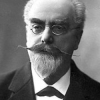Gabriel Lippmann

Gabriel Lippmann
Jonas Ferdinand Gabriel Lippmannwas a Franco-Luxembourgish physicist and inventor, and Nobel laureate in physics for his method of reproducing colours photographically based on the phenomenon of interference...
ProfessionScientist
Date of Birth16 August 1845
finals hours quarters
The series of photographic operations, developing, washing, final drying, takes about quarter of an hour.
american-psychologist colours exterior harder held might objects present sight
The photography of composite colours that exterior objects present posed a harder problem. At first sight it might have been held impossible.
layers infinity sensitive
In the case of composite colour, an infinity of systems must be obtained for maxima infinitely slight and with an infinity of interval values separating them - that is to say, the whole thickness of the sensitive layer is occupied in continuous manner by these maxima.
reflection white light
When the shot is afterwards subjected to white light, colour appears because of selective reflection.
taken rooms hospitality
Most of these pictures, taken while travelling, were developed on the mantelpiece of a hotel room, which proves that the method is easy enough to carry out.
photography lasts problem
The problem of direct colour photography has been facing us since the turn of the last century.
life-is-short progress life-is
Life is short and progress is slow
plates results protein
I got quite good results from protein plates.
american-psychologist colours destroyed perceives plate point sends thus
The plate at each point only sends back to the eye the simple colour imprinted. The other colours are destroyed by interference. The eye thus perceives at each point the constituent colour of the image.
american-psychologist due occurs phenomenon
This result is due to a phenomenon of interference which occurs within the sensitive layer.
american-psychologist distant incident rays reflected takes
During exposure, interference takes place between the incident rays and those reflected by the mirror, with the formation of interference fringes half a wavelength distant from each other.
american-psychologist began exposure fifteen length minute minutes
The length of exposure (one minute in sunlight) is still too long for the portrait. It was fifteen minutes when I first began my work. Progress may continue.
believe thinking curves
[On the Gaussian curve, remarked to Poincaré:] Experimentalists think that it is a mathematical theorem while the mathematicians believe it to be an experimental fact.